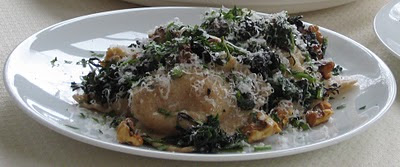2011 brings with it, among other things, a gratifying spike of new subscribers (welcome!), a distinct lack of the stomach bug that stamped out any lingering culinary enthusiasm from 2010 (phew), and (are you ready?) a new, long-coveted, sleek and silver
PASTA MACHINE. Thereby inevitably triggering the latest
alliterative quest for whole-grain-infused Italian food.
Our first attempt at multigrain pasta dough was surprisingly uncatastrophic. But it turns out that fava flour, while beguiling in theory, tastes like fava. Strongly of fava. As in, thoroughly permeates your lovingly hand-crafted roasted squash ravioli even when used in very small quantities. But now we know, and, as G.I. Joe would say if he ever attended pasta parties, knowing is half the pasta dough battle.
In the meantime, though, the ravioli filling and sauce (loosely adapted from
this recipe) were delectable enough to warrant posting, and will work with plain old egg-and-semolina pasta dough as well as with our yet-to-be-perfected multigrain blend.
Ingredients
For the filling:
1 cup roasted squash puree (we used a papaya squash, which was wonderfully flavorful and made a very thick puree, but you could also use some other heirloom variety or butternut)
Olive oil
 Pasture butter
Pasture butter
3 tbsp minced shallot
Salt & freshly ground white pepper
Liberal sprinkling of freshly ground nutmeg
1 tbsp pastured cream
For the sauce:
Handful of freshly toasted walnuts, broken into pieces
Olive oil
1 clove garlic, pressed
6-10 sage leaves, chopped
Several handfuls baby red mustard greens, chopped
(or substitute a handful of regular mustard greens, finely chopped, and increase the spinach)
A handful of spinach, chopped
Handful flat leaf parsley, chopped
Freshly grated Parmesan Reggiano
Melt a small pat of butter and about 1/2 tbsp olive oil in a pan over medium heat. Add the shallot and cook for 2-4 minutes until soft and just translucent, then fold in the squash puree. Continue to saute for a couple minutes (or more, if the squash is on the wetter side -- you want the mixture to be relatively thick). Stir in the cream, sprinkle with salt, white pepper, and nutmeg to taste, and set aside to cool.

Dust your pasta machine and a wooden cutting board with a little bit of flour. Take the pasta dough and break off a piece about the size of a fist (my husband pointed out that it was the size of my fist, not his, so envision a petite female fist as you do this if you're a towering giant like him), and feed it through the thickest setting of your pasta machine (Setting 1). Fold it in half, and repeat a few times (the goal is to make this starting piece kind of wide and rectangular, rather than long and skinny). Then, feed it through again on Setting 2, and continue working your way up the numbers until you reach Setting 7. (Note that it's much easier to do this with two people, so that one person can feed it in and turn the crank while the other guides it back out again). Hang each sheet on a pasta tree (or "pasta rack," if you prefer, which I don't) to dry a little as you prepare the rest.

Cut each sheet into rectangles of desired size (a pastry cutter works well here, or just a table knife, and ours were about 3.5" x 4.5"). Set the rectangle so that the shorter side is closest to you (make sure the surface beneath it has been lightly dusted with flour). Place a spoonful of filling at the center of the rectangle, and fold in half by bringing the furthest side to meet the closest side. Press those two sides together firmly to seal, then press to seal the right and left edges, moving inward until the filling in the center is well-defined. Trim the edges with a pastry cutter, if desired, or pinch to form a wonton shape.
For the sauce, heat a glug or two of olive oil in a deep saute pan over medium heat for about 30 seconds, and add in the garlic. Saute for a minute or two until it softens, then add the sage and stir a few times. Next, add the greens and saute until just wilted. Season with salt and white pepper to taste, and turn off the heat.
Drop pasta into rapidly boiling water and cook for 2-4 minutes until the pasta changes color (if you're not sure, fish one out, rinse it gently with a little cold water, and take a bite). Drain, then add to the pan with the sauce. Drizzle with a little olive oil, add the walnuts, and toss everything together. Serve topped with freshly grated Parmesan and parsley.
Serves 2-3.





















